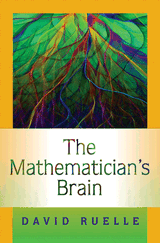The Mathematician's Brain:
|

|
In the Preface the author outright states the purpose of the book:
... would like to see how the human mind, or we may say the mathematician's mind, comes to grips with mathematical reality.
My ambition is to present here a view of mathematics and mathematicians that will interest those without training in mathematics, as well as the many who are mathematically literate.
The author achieves the set goal admirably providing a very enjoyable read along the way. At the outset, I was misled by the title into expecting an attempt to explain how a mathematician's mind works. And, in a sense, the reader does get a glimpse into the working of a mathematician's mind, albeit indirectly.
As the author - a notable mathematical physicist, an expert in non-linear dynamics (chaos and turbulence) - wrote in the first chapter,
Mathematics is a human activity carried out by individuals in a historical setting and within a societal framework. This is how the author mentions such famous mathematicians as I. Newton, F. Klein, H. Poincaré J. Hadamard, D. Hilbert, K. Gödel, A. Turing, A. Grothendieck and many others. The author finds room to talk of the antisemitic attitude of the math education establishment in the USSR and of the hierarchical snobbism of the academic establishment in France.
In Chapter 17, the author sums up his ideas about the human endeavor which is doing mathematics:
I feel that this metaphor fully applies to the book itself. The mathematician David Ruelle had set out to wrestle with a problem of presenting "the intellectual processes of the scientists and in particular (about) my own work." The book is a depiction - likely considerably trimmed - of the itinerary that his quest to understand the scientific activity took him through the labyrinth of interrelated ideas. The account is fascinating, but "one should not forget that, besides beautiful mathematical ideas, there are many more obscure things that crawl in the mind of a mathematician" (Chapter 19, p. 107.)
The book is organized into 23 small (4-6 pages) chapters which, in addition to its lucid style, make the book even more readable. The chapters cover a variety of subjects from the academic environment (Mathematics and Ideology, Honors), the mathematical language (Structures, Mathematical Texts, Infinity), the process of invention (Foundations, Structures and Concept Creation, Tinkering and the Construction of Mathematical Theories) and appropriately ends with the chapter on the beauty of mathematics.
Mathematics proper is embedded judiciously and does not overload the text. Two remarkable theorem - the Butterfly Theorem and the Lee-Yang Circle Theorem - are discussed with practically complete and elegant proofs. There is a couple of annoying mistakes, too. Early in the book, on p. 7, the Pythagorean theorem is confused with its converse and later, on p. 8, it is claimed that "Kurt Gödel has shown that it is impossible (in interesting cases) to prove that a system of axioms does not lead to contradictions." However, in a note at the end of the book the author refers to Gödel's Incompleteness Theorem and correctly mentions the inconsistency of a theory as an example of those statements that can't be proved within the theory itself. On p. 66, the theorem is mentioned again and now in the correct form. On p. 74, the author misstates the Maximum Modulus Principle: a function analytic in a domain reaches its maximum on the boundary. (The statement is corrected in the accompanying note at the end of the book.)
On p. 73, the author asserts that the modern view on Euclidean geometry is via Set Theory, real numbers and analytic geometry. I do not believe this is a commonly adopted approach. It is certainly not the only one possible of which fact the author is undoubtedly aware as he readily refers to Hilbert's reworking of Euclid's axioms.
These oversights did not mar the reading of the book for me. True to the subtitle, the book delivers a personal perspective on the structure of mathematics, mathematical research and on some of the great minds behind it. The author, whom I never met, is very open-minded to the extent that, upon reading the book, I feel I may claim at least a partial acquaintance with the workings of his mind. I consider this a privilege.
The Mathematician Brain: A Personal Tour Through the Essentials of Mathematics and Some of the Great Minds Behind Them , Princeton University Press, 2007. Hardcover, 160 pp, $22.95. ISBN 0691129827.
|Up| |Contact| |Front page| |Contents|
Copyright © 1996-2018 Alexander Bogomolny71535760
